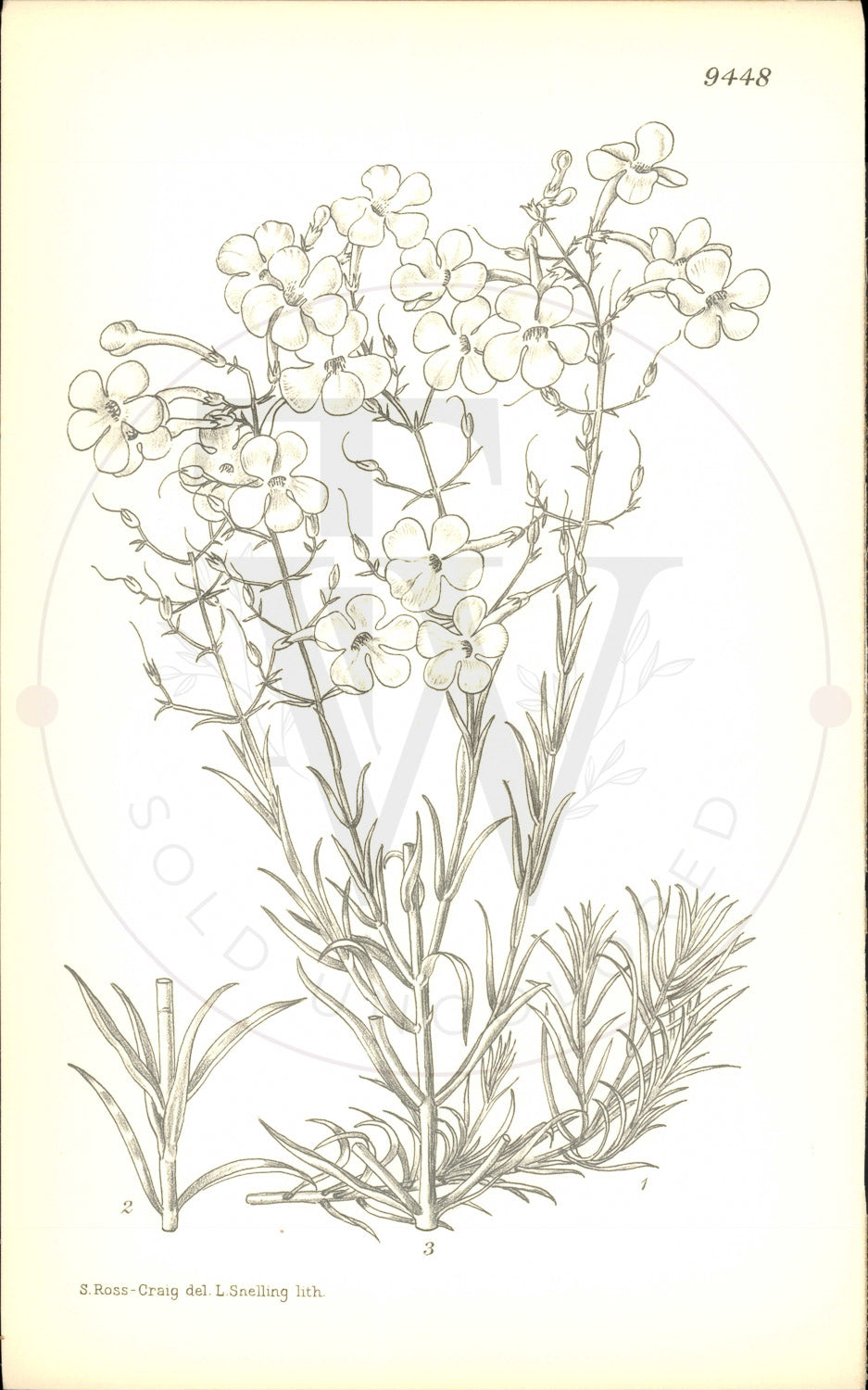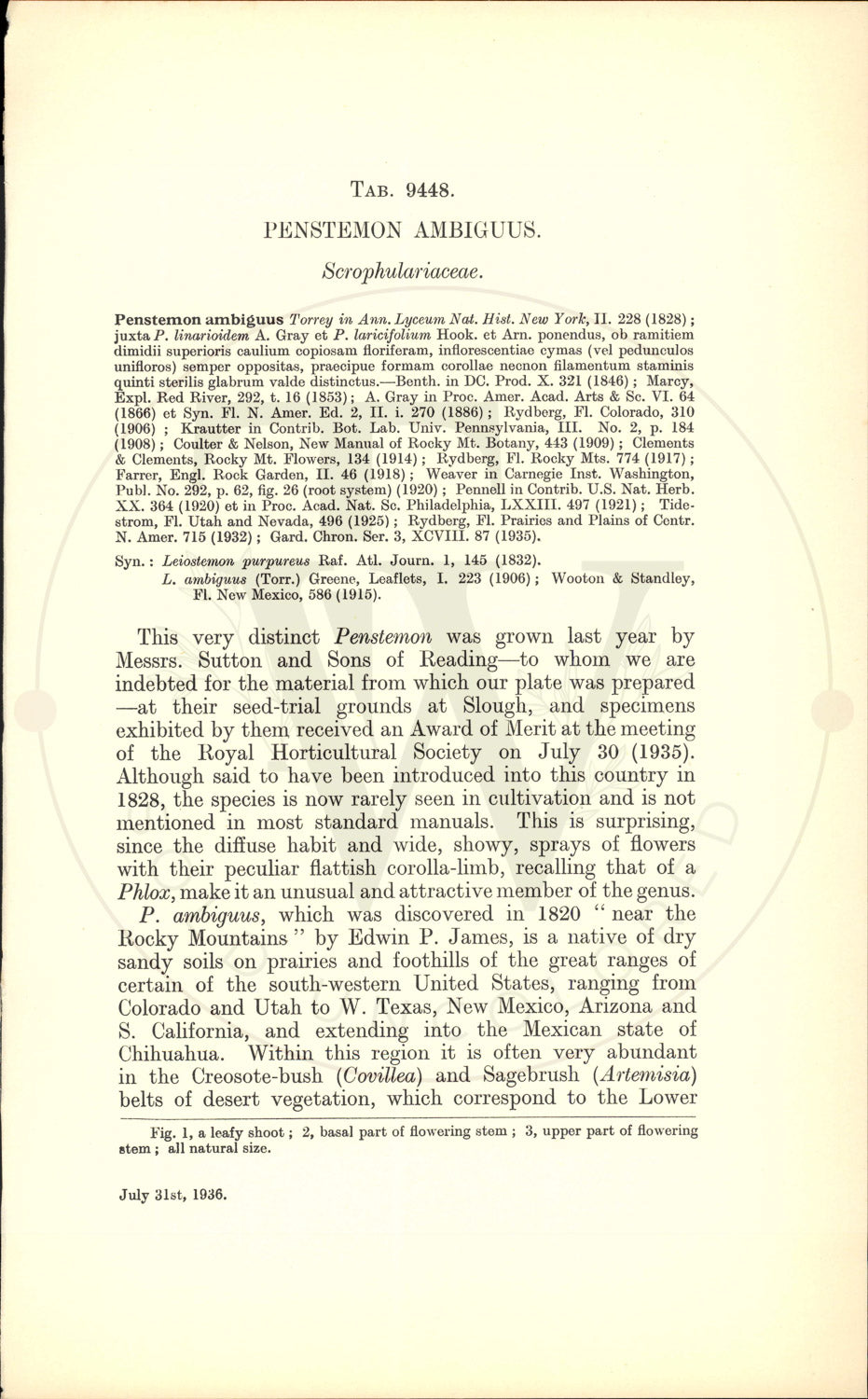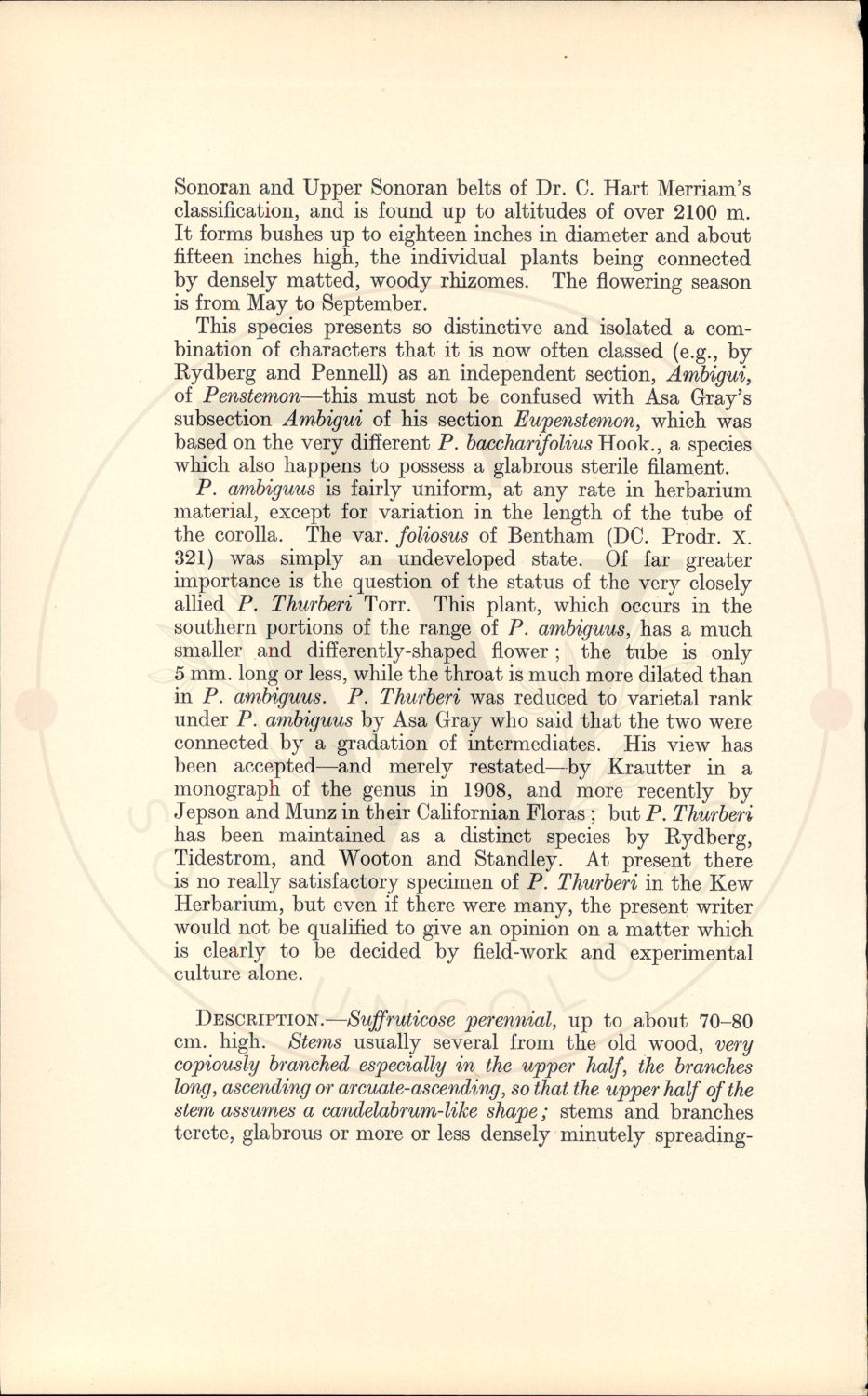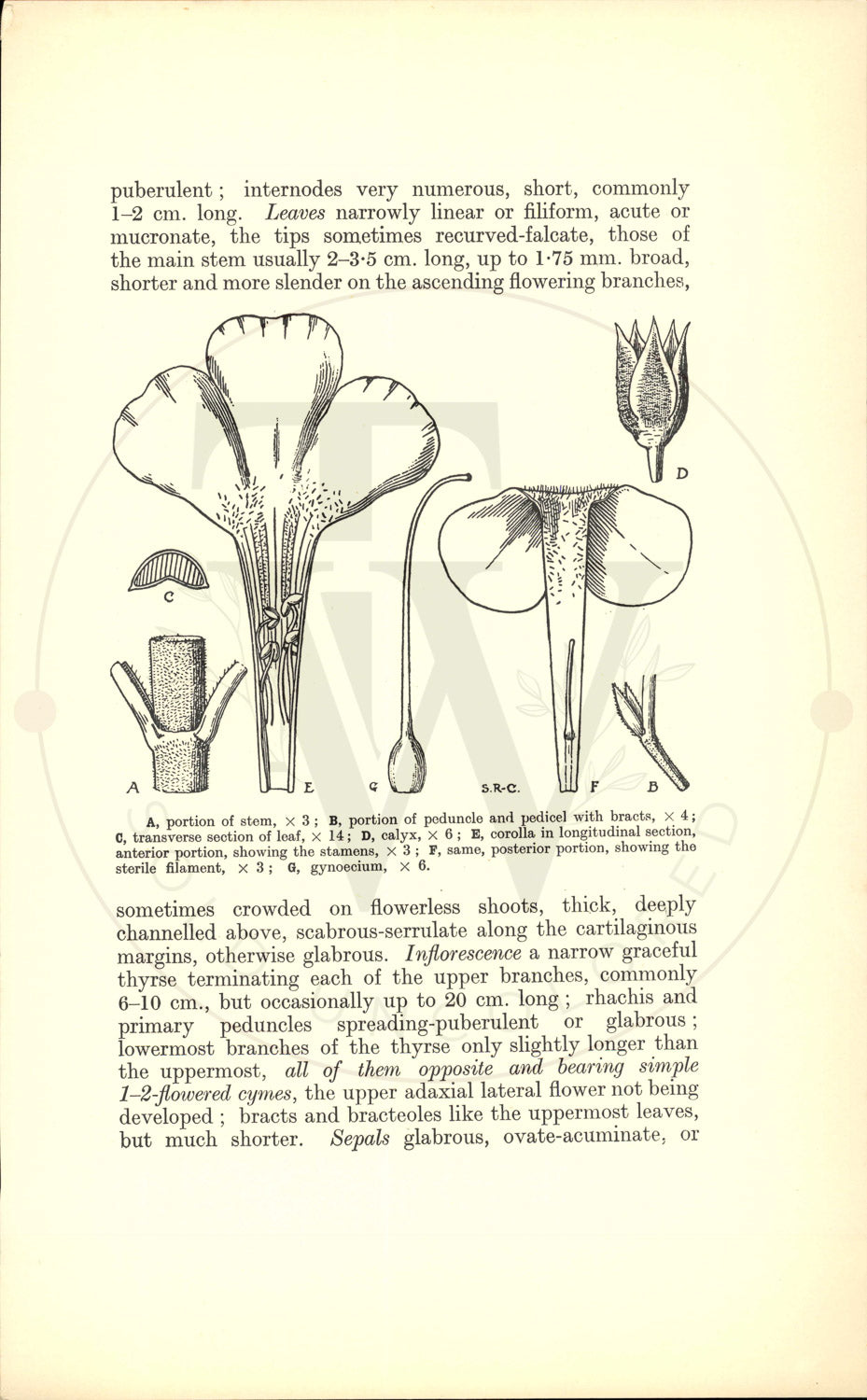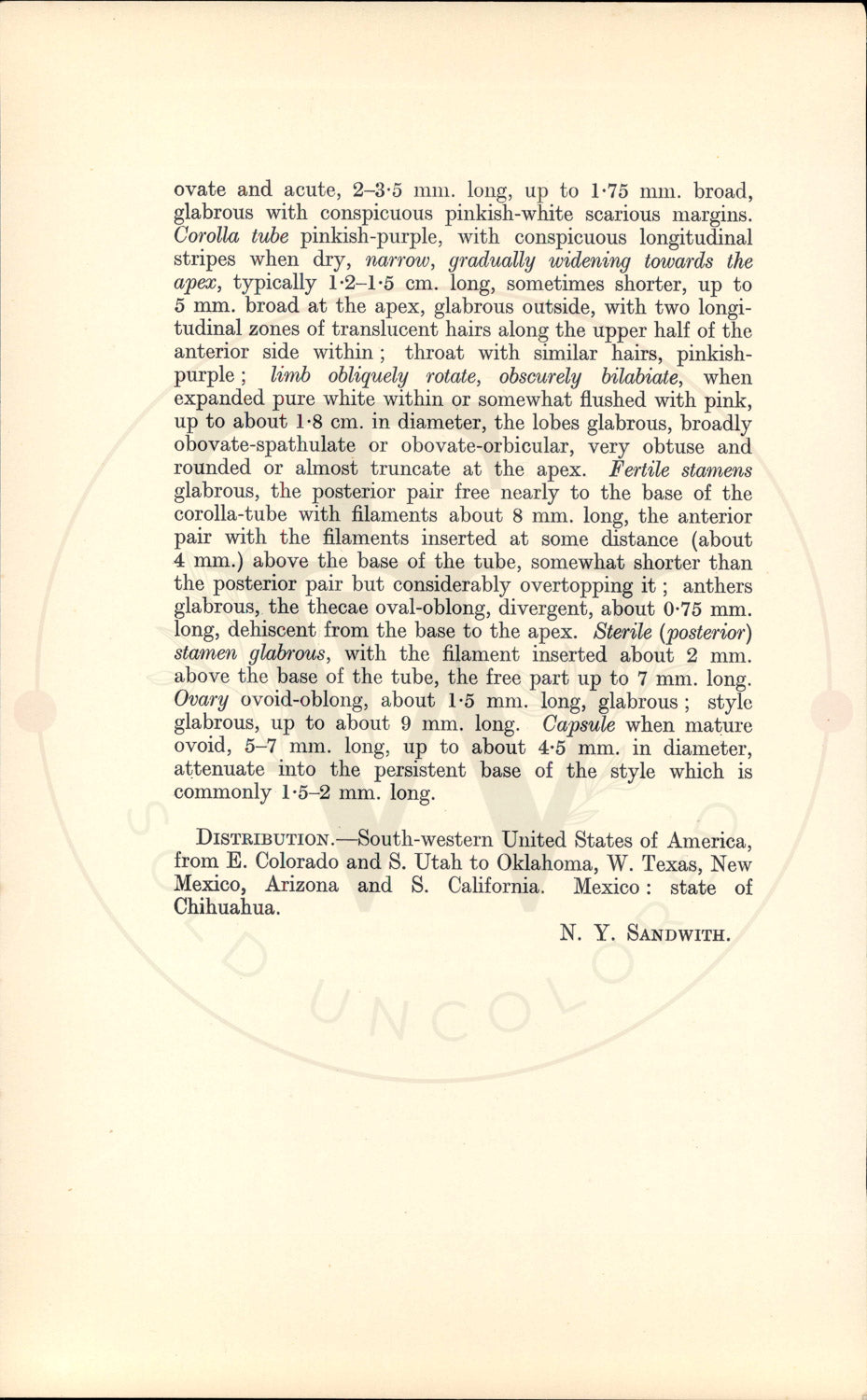Curtis Botanical Magazine
Plate 9448 - Penstemon ambiguus
Plate 9448 - Penstemon ambiguus
Couldn't load pickup availability
Curtis's Botanical Magazine - Plate 9448
Penstemon ambiguus
Native Region: California • Publication Date: January 1st, 1934
Distribution: -South-western United States of America, • Tab Author: N. Y. SANDWITH
Botanical Description
Fifteen inches high, the individual plants being connected by densely matted, woody rhizomes. The flowering season is from May to September. This species presents so distinctive and isolated a com- bination of characters that it is now often classed (e.g., by Rydberg and Pennell) as an independent section, Ambigui, of Penstemon-this must not be confused with Asa Gray's subsection Ambigui of his section Eupenstemon, which was based on the very different P. baccharifolius Hook., a species which also happens to possess a glabrous sterile filament. P. ambiguus is fairly uniform, at any rate in herbarium material, except for variation in the length of the tube of the corolla. The var. foliosus of Bentham (DC. Prodr. X. 321) was simply an undeveloped state. Of far greater importance is the question of the status of the very closely allied P. Thurberi Torr. This plant, which occurs in the southern portions of the range of P. ambiguus, has a much smaller and differently-shaped flower; the tube is only 5 mm. long or less, while the throat is much more dilated than in P. ambiguus. P. Thurberi was reduced to varietal rank under P. ambiguus by Asa Gray who said that the two were connected by a gradation of intermediates. His view has been accepted-and merely restated-by Krautter in a monograph of the genus in 1908, and more recently by Jepson and Munz in their Californian Floras; but P. Thurberi has been maintained as a distinct species by Rydberg, Tidestrom, and Wooton and Standley. At present there is no really satisfactory specimen of P. Thurberi in the Kew Herbarium, but even if there were many, the present writer would not be qualified to give an opinion on a matter which is clearly to be decided by field-work and experimental culture alone. DESCRIPTION. Suffruticose perennial, up to about 70-80 cm. high. Stems usually several from the old wood, very copiously branched especially in the upper half, the branches long, ascending or arcuate-ascending, so that the upper half of the stem assumes a candelabrum-like shape; stems and branches terete, glabrous or more or less densely minutely spreading- puberulent; internodes very numerous, short, commonly 1-2 cm. long. Leaves narrowly linear or filiform, acute or mucronate, the tips sometimes recurved-falcate, those of the main stem usually 2-3.5 cm. long, up to 1.75 mm. broad, shorter and more slender on the ascending flowering branches, A E S.R-C. F B D A, portion of stem, x 3; B, portion of peduncle and pedicel with bracts, x 4%;B C, transverse section of leaf, x 14; D, calyx, x 6; E, corolla in longitudinal section, anterior portion, showing the stamens, x 3; F, same, posterior portion, showing the sterile filament, x 3; G, gynoecium, x 6. sometimes crowded on flowerless shoots, thick, deeply channelled above, scabrous-serrulate along the cartilaginous margins, otherwise glabrous. Inflorescence a narrow graceful thyrse terminating each of the upper branches, commonly 6-10 cm., but occasionally up to 20 cm. long; rhachis and primary peduncles spreading-puberulent or glabrous; lowermost branches of the thyrse only slightly longer than the uppermost, all of them opposite and bearing simple 1-2-flowered cymes, the upper adaxial lateral flower not being developed; bracts and bracteoles like the uppermost leaves, but much shorter. Sepals glabrous, ovate-acuminate, or ovate and acute, 2-3.5 mm. long, up to 1.75 mm. broad, glabrous with conspicuous pinkish-white scarious margins. Corolla tube pinkish-purple, with conspicuous longitudinal stripes when dry, narrow, gradually widening towards the apex, typically 1.2-1.5 cm. long, sometimes shorter, up to 5 mm. broad at the apex, glabrous outside, with two longi- tudinal zones of translucent hairs along the upper half of the anterior side within; throat with similar hairs, pinkish- purple; limb obliquely rotate, obscurely bilabiate, when expanded pure white within or somewhat flushed with pink, up to about 1.8 cm. in diameter, the lobes glabrous, broadly obovate-spathulate or obovate-orbicular, very obtuse and rounded or almost truncate at the apex. Fertile stamens glabrous, the posterior pair free nearly to the base of the corolla-tube with filaments about 8 mm. long, the anterior pair with the filaments inserted at some distance (about 4 mm.) above the base of the tube, somewhat shorter than the posterior pair but considerably overtopping it; anthers glabrous, the thecae oval-oblong, divergent, about 0.75 mm. long, dehiscent from the base to the apex. Sterile (posterior) stamen glabrous, with the filament inserted about 2 mm. above the base of the tube, the free part up to 7 mm. long. Ovary ovoid-oblong, about 1.5 mm. long, glabrous; style glabrous, up to about 9 mm. long. Capsule when mature ovoid, 5-7 mm. long, up to about 4.5 mm. in diameter, attenuate into the persistent base of the style which is commonly 1.5-2 mm. long. DISTRIBUTION.-South-western United States of America, from E. Colorado and S. Utah to Oklahoma, W. Texas, New Mexico, Arizona and S. California. Mexico: state of Chihuahua. N. Y. SANDWITH.
Synonyms
Fl. N. Amer. Ed. 2
(1906) Krautter in Contrib. Bot. Lab. Univ. Pennsylvania
(1908)
& Clements
Leiostemon purpureus Raf. Atl. Journ. 1
L. ambiguus (Torr.) Greene
About This Print
Original black and white uncolored botanical print from Curtis's Botanical Magazine (established 1787). This 9000s series print is from unissued publisher stock, never hand-colored, representing the authentic plate as it appeared in the magazine. Edited by Sir Arthur William Hill for The Royal Horticultural Society, London.
Share
